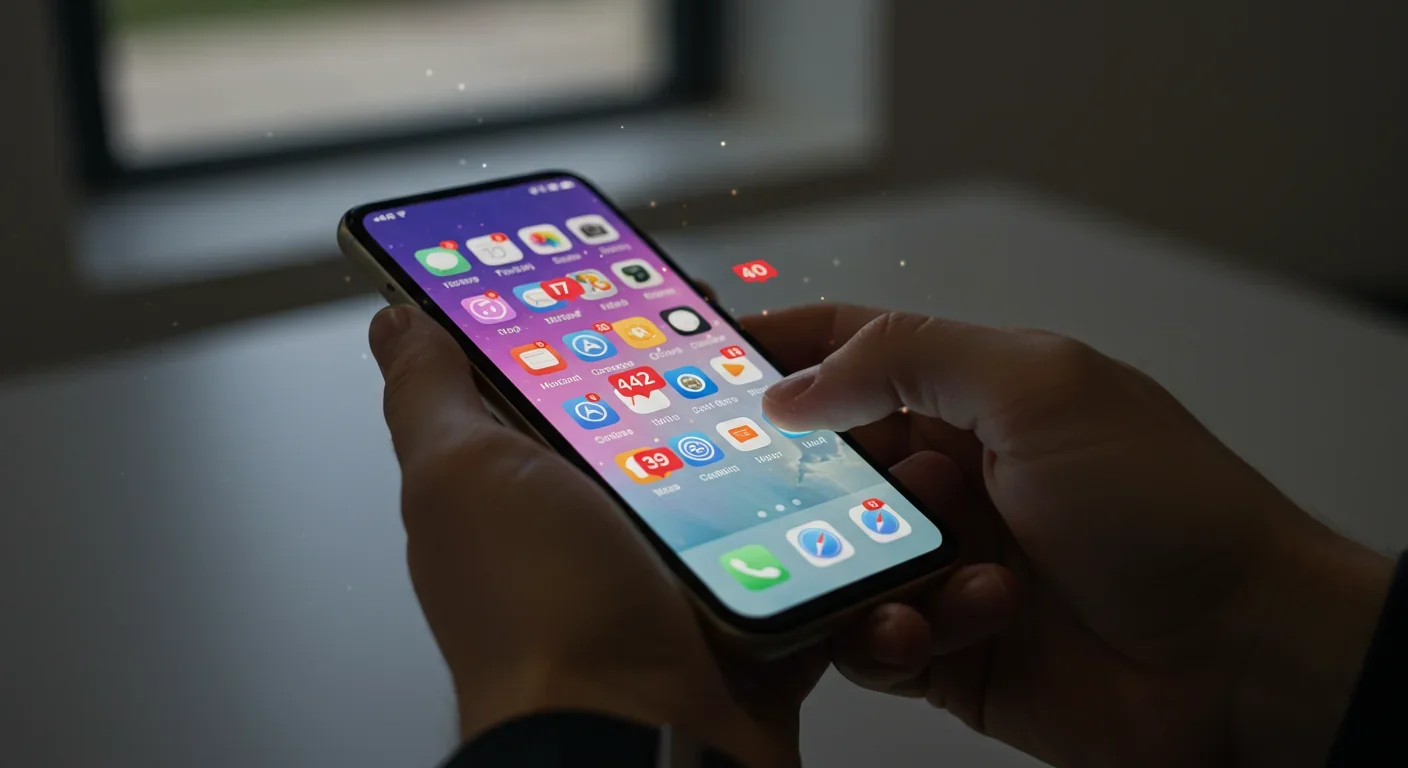The Polycrisis Generation: Youth in Cascading Crises

TL;DR: Digital notifications exploit brain reward systems through dopamine manipulation, causing measurable cognitive decline and productivity losses. The average person faces 1,200 daily interruptions costing five weeks annually, with mental health impacts including anxiety and sleep disruption. Evidence-based strategies like digital fasting and attention budgeting can help reclaim focus.
By 2030, neuroscientists predict the average person will lose nearly seven weeks of productive time annually just reorienting after digital interruptions. We're not talking about distractions anymore—we're witnessing a systematic rewiring of human cognition, driven by devices engineered to capture and commodify our attention. What started as convenience has become a crisis affecting billions of minds, and the data reveals something unsettling: we're less in control than we think.
The numbers paint a startling picture. American smartphone users receive at least 46 push notifications daily, but that's just the beginning. When you add email alerts, messaging pings, app badges, and desktop notifications, the average knowledge worker faces nearly 1,200 context switches per day—toggling between applications and websites in a frenetic digital dance.
These aren't random interruptions. They're precision-engineered triggers, timed and personalized to hit when you're most vulnerable. Persuasive design principles—including social proof, scarcity, variable rewards, and behavioral triggers—exploit cognitive weaknesses to keep you engaged. Every notification represents a calculated bet that you'll stop what you're doing and click.
Half of all users find push notifications annoying, yet most keep them enabled. Research shows tolerance breaks somewhere between 2 to 6 notifications per week—after that, people start opting out. But by then, the damage to attention patterns has already begun.
Understanding why notifications feel irresistible requires looking at your brain's reward circuitry. The mesocorticolimbic pathway—connecting the ventral tegmental area to the nucleus accumbens—generates something called incentive salience, neuroscience jargon for "wanting." When dopamine floods this circuit, it creates a powerful motivational drive that can override whatever you're currently doing.
Tech platforms deliberately trigger these dopamine releases. Each ping, like, or share delivers a micro-reward, creating feedback loops that keep you coming back. Neuroimaging studies confirm that notification alerts activate the same brain regions as gambling, drugs, and alcohol—the nucleus accumbens lights up identically.
Here's where it gets concerning: repeated dopamine hits without effort lead to desensitization. Your brain becomes less responsive to normal rewards. Attention span shrinks dramatically, routine tasks feel boring, challenging work seems impossible. The neural pathways literally prune themselves, trimming away branches to make the reward route faster and more automatic.

Modern life is designed to give you constant dopamine hits. When you're consistently exposed to instant gratification, it erodes your ability to sustain focus and motivation on tasks that actually matter.
Every switch carries a price. Studies show it takes an average of 9.5 minutes to regain productive focus after toggling to a different app. Email alone was estimated to cause 96 interruptions during an 8-hour workday, adding up to 1.5 hours daily just reorienting.
The math becomes brutal when you scale it out. Digital workers spend nearly 4 hours per week recovering from context switches—that's about five weeks annually of pure cognitive overhead. And chronic multitasking doesn't just waste time; research indicates it can consume 40% of productive capacity and may temporarily drop IQ by up to 10 points.
These aren't just productivity statistics—they represent fundamental changes in how our brains process information. The attention economy operates on a simple premise: human attention is scarce, valuable, and can be harvested. Tech companies have built trillion-dollar businesses on capturing microseconds of focus, aggregating them into hours of engagement.

"The constant context-switching depletes our mental resources, degrades decision quality, and paradoxically extends the time it takes each of us on work related tasks."
— Legal professionals observing the impact of continuous partial attention
What begins as productivity loss evolves into something more insidious. Studies consistently link heavy digital notification exposure to elevated stress, anxiety, and depression. The relationship isn't coincidental—it's mechanistic.
Attention fragmentation impairs the ability to engage in deep, meaningful work or sustained social connection. Every interruption creates a low-level stress response as your brain scrambles to assess relevance, context-switch, then attempt to resume the previous task. Multiply that by dozens or hundreds of times daily, and you're living in a state of perpetual low-grade emergency.
Sleep takes a particularly hard hit. Blue light emission and stimulating content interfere with circadian rhythms, leading to insomnia and sleep disruption. Checking your phone before bed—something most people do reflexively—primes your reward system for activation right when you should be winding down.
Emerging research suggests heavy social media use may disrupt the default mode network, the brain system responsible for self-reflection, imagination, and emotional regulation. When you're constantly responding to external pings, you never activate the internal processing that builds coherent identity and emotional resilience.
None of this happens by accident. The notification ecosystem emerged from decades of research into behavioral psychology, particularly B.J. Fogg's Behavior Model and principles from social psychology. The formula is elegant: create desire, ensure ability, provide trigger—repeat endlessly.
Push notifications, autoplay features, and infinite scrolling represent engineering feats designed specifically to exploit reward circuitry. Variable reward schedules—the same mechanism that makes slot machines addictive—keep you checking because you never know when something interesting might appear.

Dark patterns—interface designs that mislead users into unwanted actions—make it harder to opt out than opt in. Notification settings are deliberately complex, buried in menus, with default states that favor maximum interruption. Companies profit from engagement time, so they architect systems where saying "no" requires constant effort while saying "yes" happens automatically.
Social proof amplifies the effect. When you see "273 people liked this" or "5 of your friends are watching," you experience FOMO—fear of missing out—that transcends rational evaluation. These aren't information displays; they're psychological levers calibrated to overcome your better judgment.
Office workers react to incoming emails within 6 seconds of arrival, demonstrating how notification design has conditioned near-instantaneous response patterns that override deliberate task prioritization.
Beyond individual psychology, notification culture reshapes social dynamics. Continuous partial attention—being sort-of present in multiple contexts simultaneously—becomes the default mode of interaction. You're in a meeting but checking Slack. Having dinner with family but glancing at your phone. Theoretically available everywhere while being fully present nowhere.
Relationships suffer measurable degradation. Partners report feeling devalued when conversations get interrupted by device checks. Children internalize that screens deserve immediate attention while people can wait. The subtle message embedded in every mid-conversation notification check: whatever's on the phone matters more than whoever's in front of you.
Professionally, notification overload creates what researchers call "attention budgeting" challenges. Knowledge workers must now actively allocate focused blocks of time and create protective environments just to achieve what used to be normal concentration. Deep work—the sustained focus required for complex problem-solving—becomes a rare luxury rather than a baseline expectation.

The economic costs scale frighteningly. When you multiply individual productivity losses across entire organizations, you're looking at billions in lost output. Workers spend about 59 minutes daily just searching for information scattered across applications. Companies respond by adding more communication tools, which paradoxically increases context-switching rather than reducing it.
Fighting back starts with understanding the dopamine trap. Instant gratification erases the motivational power of anticipation—when everything comes effortlessly, nothing feels rewarding. Breaking this cycle requires deliberate effort-based rewards that rebuild dopamine sensitivity.
Individual strategies that show effectiveness:
Digital fasting: Taking regular periods offline—from hours to entire days—resets reward system sensitivity. Your brain recalibrates what constitutes a meaningful stimulus.
Attention budgeting: Allocating focused blocks specifically for deep work, then creating physical and digital environments that support sustained concentration. This means airplane mode, closed doors, and explicit boundaries.
Notification boundaries: Turn off everything that isn't truly urgent. Most people need maybe 3-5 notifications enabled; the rest represent manufactured urgency. Setting specific "dopamine windows" when you allow checking keeps impulse control intact.
Tool integration: Consolidating communication platforms and automating repetitive tasks dramatically reduces switch frequency. When ticketing, messaging, and project management live in one place rather than ten, you eliminate hundreds of daily toggles.
Effort over instant gratification: Breaking larger tasks into milestones that deliver earned dopamine hits—rather than random ones from notifications—helps retrain reward pathways toward meaningful accomplishment.

"You're not lazy or distracted—you're overstimulated and under-satisfied. The solution isn't more willpower; it's changing the environment that keeps hijacking your attention."
— Psychology researchers on dopamine desensitization
Some tech companies are implementing features like screen time tracking and break reminders. Apple's Screen Time and Android's Digital Wellbeing represent acknowledgment that engagement maximization creates harm. But these tools remain optional, often hidden, and easily ignored—hardly aggressive interventions given the scale of the problem.
More promising are organizational approaches. Companies are experimenting with meeting-free days, asynchronous communication defaults, and explicit policies protecting focus time. Some mandate "no notifications after 6 PM" rules or establish response-time expectations that don't assume instant availability.
Regulatory frameworks lag behind the neuroscience. The concept of "interrupt rights"—legal protections for sustained attention—remains largely theoretical. France's "right to disconnect" law, which prohibits work emails outside business hours, represents one of few policy experiments acknowledging that attention deserves protection.
The fundamental tension remains: platforms profit from engagement, which requires interruption, which degrades the attention required for everything else humans value. Until that incentive structure changes—through regulation, competition, or cultural shift—notification overload will persist as a feature, not a bug.
The notification apocalypse isn't coming—it arrived years ago, and we're still adapting to the wreckage. But human brains retain remarkable plasticity. Dopamine pathways can be retrained, attention spans can recover, and focus can be rebuilt, even after years of fragmentation.
The question isn't whether technology serves us or we serve it—that battle's over, and the answer depends entirely on choices we make. Do you accept default notification settings designed to maximize someone else's engagement metrics? Or do you deliberately architect an attention environment that serves your goals?
Every notification you silence, every app badge you disable, every focus block you protect represents a small act of cognitive sovereignty. Aggregated across days, weeks, and years, these choices determine whether you spend your finite attention on what genuinely matters or fritter it away responding to engineered urgency.
We're at a crossroads. One path leads to further fragmentation, where sustained thought becomes impossible and human connection degrades to reactive button-pushing. The other requires deliberate resistance to systems designed to capture and monetize every available second of consciousness.
The technology won't change on its own—the economics are too compelling. But individual choices, amplified by social norms and eventually policy frameworks, can shift what's acceptable. Maybe someday we'll look back at early-21st-century notification culture the way we now view cigarette advertising or leaded gasoline: an obvious public health hazard we temporarily normalized before coming to our senses.
Until then, every ping is a test. Every alert a choice. Every interruption an opportunity to practice what researchers call "intentional attention"—the radical act of deciding for yourself what deserves your focus, regardless of what engineered persuasion suggests.
The notification apocalypse reshaped how we think, work, relate, and rest. Understanding the mechanisms behind that reshaping is the first step toward taking control back. The science is clear, the stakes are high, and the choice—as always—is yours.

Lunar mass drivers—electromagnetic catapults that launch cargo from the Moon without fuel—could slash space transportation costs from thousands to under $100 per kilogram. This technology would enable affordable space construction, fuel depots, and deep space missions using lunar materials, potentially operational by the 2040s.

Ancient microorganisms called archaea inhabit your gut and perform unique metabolic functions that bacteria cannot, including methane production that enhances nutrient extraction. These primordial partners may influence longevity and offer new therapeutic targets.

CAES stores excess renewable energy by compressing air in underground caverns, then releases it through turbines during peak demand. New advanced adiabatic systems achieve 70%+ efficiency, making this decades-old technology suddenly competitive for long-duration grid storage.

Human children evolved to be raised by multiple caregivers—grandparents, siblings, and community members—not just two parents. Research shows alloparenting reduces parental burnout, improves child development, and is the biological norm across cultures.

Soft corals have weaponized their symbiotic algae to produce potent chemical defenses, creating compounds with revolutionary pharmaceutical potential while reshaping our understanding of marine ecosystems facing climate change.

Generation Z is the first cohort to come of age amid a polycrisis - interconnected global failures spanning climate, economy, democracy, and health. This cascading reality is fundamentally reshaping how young people think, plan their lives, and organize for change.

Zero-trust security eliminates implicit network trust by requiring continuous verification of every access request. Organizations are rapidly adopting this architecture to address cloud computing, remote work, and sophisticated threats that rendered perimeter defenses obsolete.